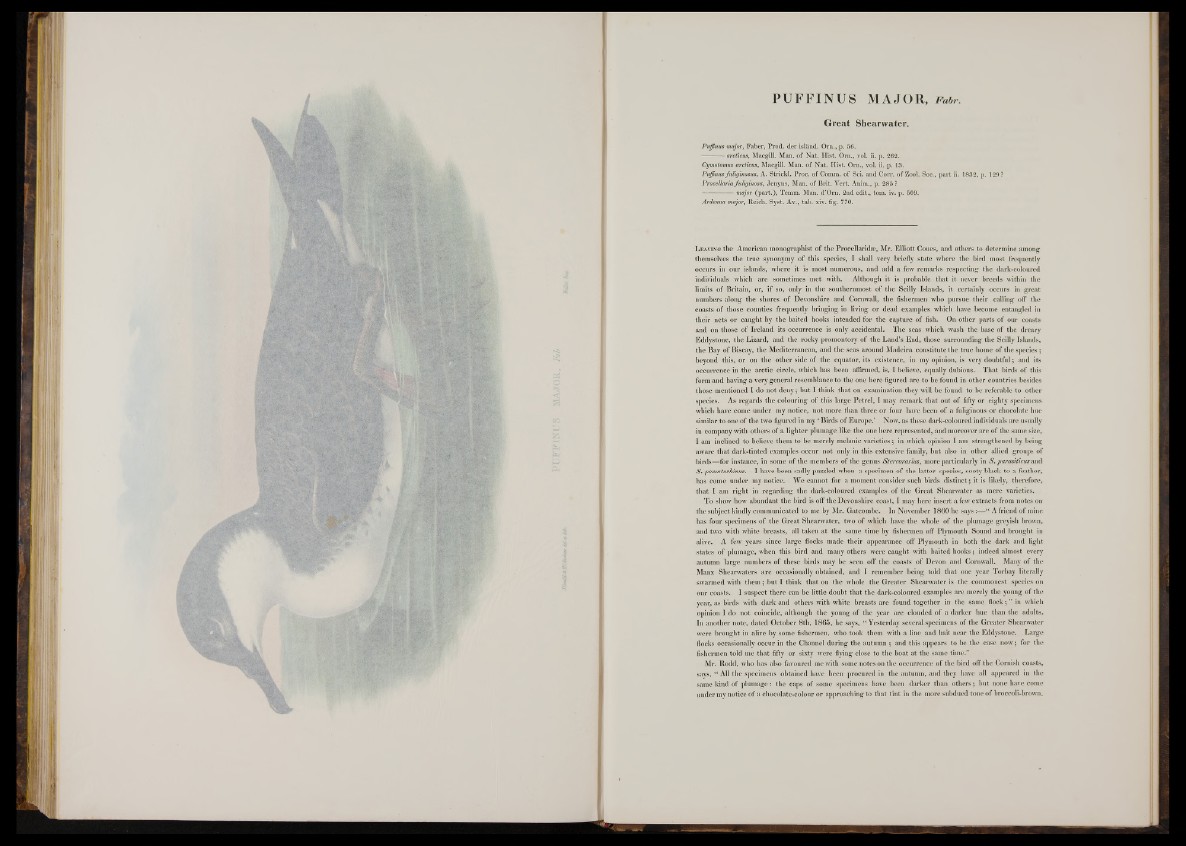
Great Shearwater.
Pujjinus major, Faber, Prod, der island. Orn., p. 66.
arcticus, Macgill. Man. of Nat. Hist. Orn., vol. ii. p. 262.
Cymotomus arcticus, Macgill. Man. of Nat. Hist. Orn., vol. ii. p. 13.
Puffmus fuliginosas, A. Strickl. Proc. of Comm, of Sci. and Corr. of Zool. Soc., part ii. 1832, p. 129 ?
Procellaria fuliginosa, Jenyns, Man. of Brit. Vert. Anim., p. 285 ?
---------------major (part.), Temm. Man. d’Oru. 2nd edit., tom. iv. p. 509.
Ardenna major, Reich. Syst. Av., tab. xiv. fig. 770.
L e a v in g the American monographist o f the Procellaridas, Mr. Elliott Coues, and others to determine among
themselves the trne synonymy o f this species, I shall very briefly state where the bird most frequently
occurs in our islands, where it is most numerous, and add a few remarks respecting the dark-coloured
individuals which are sometimes met with. Although it is probable that it never breeds within the
limits o f Britain, or, if so, only in the southernmost o f the Scilly Islands, it certainly occurs in great
numbers along the shores o f Devonshire and Cornwall, the fishermen who pursue their calling off the
coasts o f those counties frequently bringing in living or dead examples which have become entangled in
their nets or caught by the baited hooks intended for the capture o f fish. On other parts of our coasts
and on those o f Ireland its occurrence is only accidental. The seas which wash the base o f the dreary
Eddystone, the Lizard, and the rocky promontory o f the Land’s End, those surrounding the Scilly Islands,
the Bay of Biscay, the Mediterranean, and the seas around Madeira constitute the true home o f the species;
beyond this, or on the other side o f the equator, its existence, in my opinion, is very doubtful; and its
occurrence in the arctic circle, which has been affirmed, is, I believe, equally dubious- That birds of this
form and having a very general resemblance to the one here figured are to be found in other countries besides
those mentioned I do not deny; but I think that on examination they will be found to be referable to other
species. As regards the colouring of this large Petrel, I may remark that out o f fifty or eighty specimens
which have come under my notice, not more than three or four have been o f a fuliginous or chocolate hue
similar to one o f the two figured in my ‘ Birds o f Europe.’ Now, as these dark-coloured individuals are usually
in company with others o f a lighter plumage like the one here represented, and moreover are o f the same size,
I am inclined to believe them to be merely melanic varieties; in which opinion I am strengthened by being
aware that dark-tinted examples occur not only in this extensive family, but also in other allied groups of
birds—for instance, in some o f the members o f the genus Stercorarius, more particularly in S . parasiticus m d
S . pomatorhinus. I have been sadly puzzled when a specimen o f the latter species, sooty-black to a feather,
has come under my notice- We cannot for a moment consider such birds distinct; it is likely, therefore,
that I am right in regarding the dark-coloured examples o f the Great Shearwater as mere varieties.
To show how abundant the bird is off the Devonshire coast, I may here insert a few extracts from notes on
the subject kindly communicated to me by Mr. Gatcombe. In November 1860 he says:— “ A friend o f mine
has four specimens o f the Great Shearwater, two of which have the whole o f the plumage greyish brown,
and two with white breasts, all taken at the same time by fishermen off Plymouth Sound and brought in
alive. A few years since large flocks made their appearance off Plymouth in both the dark and light
states o f plumage, when this bird and many others were caught with baited hooks; indeed almost every
autumn large numbers o f these birds may be seen off the coasts o f Devon and Cornwall. Many o f the
Manx Shearwaters are occasionally obtained, and I remember being told that one year Torbay literally
swarmed with them; but I think that on the whole the Greater Shearwater is the commonest species on
our coasts. I suspect there can be little doubt that the dark-coloured examples are merely the young of the
yeai;, as birds with dark and others with white breasts are found together in the same flock; ” in which
opinion I do not coincide, although the young o f the year are clouded o f a darker hue than the adults.
In another note, dated October 8 th, 1865, he says, “ Yesterday several specimens of the Greater Shearwater
were brought in alive by some fishermen, who took them with a line and bait near the Eddystone. Large
flocks occasionally occur in the Channel during the autumn ; and this appears to be the case now; for the
fishermen told me that fifty or sixty were flying close to the boat at the same tiine.”;
Mr. Rodd, who has alsb favoured me with some notes on the occurrence o f the bird off the Cornish coasts,
says, “ All the specimens obtained have been procured in the autumn, and they have all appeared in the
same kind o f plumage: the caps o f some specimens have been darker than others; but none have come
under my notice o f a chocolate-colour or approaching to that tint in the more subdued tone o f broccoli-brown.